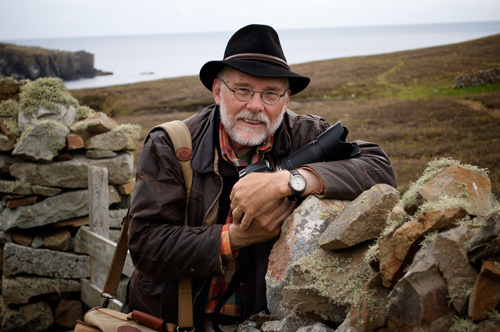
ROAD TRIP: NIGHT SKIES AND LONG DAYS
On the road. On assignment. Sounds romantic, right? Well I’m here to tell you — it is, actually! But probably not the way you think.
And probably only if you are a photographic nutcase like me. And since this is Scott Kelby’s blog I’m pretty sure that you are, in fact, a nutcase like me too! So it will be a pleasure to do a little bit of preaching to the choir, and I’m honored to get the chance to do it here.
I thought long and hard about what might be of interest, and went back over recent stories I’ve shot for National Geographic (I’ve been working for the magazine for more than 25 years now.) Somehow I kept coming back to one moment which seemed to boil down the whole experience of shooting a recent story. And I thought I’d take you along on the journey.
That moment came as I was driving down I-70, somewhere west of Kansas City. Already I had driven over 3,000 miles on this mega-jaunt in pursuit of a story. I was looking out the windshield for clear skies, but the weather app on my iPhone was giving me bad news. Chicago, my destination tonight, was socked in. No way that I was going to shoot the nighttime aerial of the city I had planned for that night. But maybe the cloud cover over the whole midwest would make something interesting in St. Louis. So I diverted. I made the decision: I’d drive to St. Louis instead of Chicago and take my chances.
That moment of decision has come to symbolize for me what I love about shooting stories. One way or another, I have the freedom to go wherever the pictures were. That’s my job, chasing great pictures.
In many ways taking chances to get great pictures was exactly what this story on light pollution was all about. It was an obscure story about an obscure subject. Most people I told about it had no idea what I was talking about. But then I’d remind them how they used to be able to see the Milky Way before all the city lights got so bright, and they’d nod and tell me some tale about how they remembered seeing the stars on grandpa’s farm when they were kids. Exactly! They didn’t know it, but they were experts on the subject of light pollution. It was my job to make that all graphically real.
And which was why I was taking my chances driving to St. Louis that night. I was looking for places where I could see and photograph the effects of our ever-growing, world-wide hunger to light up the night. I had taken a chance telling National Geographic I could make interesting pictures out of this story. I’d convinced them it was an important story in my initial proposal but I’m not sure everyone really believed the pictures would really sing. And actually, neither was I. But it’s a lot like performing in the circus: if you don’t go out on the tightrope, nobody cheers.
I did have a secret weapon, however: I’d decided that I would drive everywhere for the shoot. The logistics had been driving me crazy. How could I arrange flights to all these locations, never being sure what the weather would do, how to adjust when I screwed up the first night of a shoot and had to go back? Finally, it came to me that I’d be shooting at night (no duh!) and so I’d have all day to drive. I could shoot a few hours from sundown until midnight. Get six hours of sleep and then drive for a good 10-12 hours the next day if I had to in order to get to the next location. Every night I’d be in one of two kinds of places: in a city which had light pollution and I’d photograph that, or in the countryside where I had dark skies, and I’d photograph that. Brilliant. In thirty days I could cover the whole United States, from coast to coast. And I did.
So that night, I got lucky. Pulling in to St. Louis by 5:00 pm I got a couple hours nap before heading out to the nearby Gateway Arch. Wonder of wonders, the heavy overcast that had quashed my shoot in Chicago that night put a layer of clouds just above the top of the arch. Sodium vapor lighting from the city streets turned the clouds a weird salmon color, and incredibly, the spotlights on the arch cast arch-shaped shadows on the the clouds, something like the Batman spotlight calling the caped crusader, straight out of the comic books. I shot it every way I could think of, and most of it looked pretty good. The wide angle shots created a sinister face look and the telephoto shots (like this one that we used in the magazine) were just abstract and intriguing. With five second exposures on my Nikon D3 the sky just glowed. And I went to sleep that night thinking I’d done something I never expected to do.
But that was halfway through the shoot.
Back to the beginning, driving west to Las Vegas:
I had planned to start the whole shoot with something I was pretty sure would work: the Luxor Hotel in Las Vegas.
With a spotlight rated at more than 42 billion candle power shining out the top I figured it just might make a picture. And since it is touted to be the brightest beam in the world I also figured it was fair game for a story about light pollution. Airline pilots say they can see it from Los Angeles. It even has environmental impact because on some nights millions of moths get caught in the beam where squadrons of birds and bats sweep in to feed on them. No such luck for me that night. Too cold (in Las Vegas?) and I had to content myself with make design pictures out of the lurking dark shape of the pyramid, the surrounding palms and the rising moon.
Next day I would be driving on with thousands of miles ahead of me. I had a trunk full of gear and my iPod loaded with music and audio books. With luck I’d have hours out of cellphone territory, where I could crank the music up loud (great territory for Mahler, moody and vast) and tell the world to get lost.
On to Mt. Wilson in California:
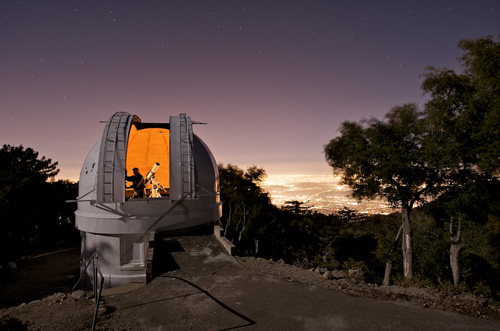
Mt. Wilson Observatory, California
Astronomy has always fascinated me since I first saw the rings of Saturn through my Uncle Bob’s homemade telescope when I was a boy on the farm back in Kansas. And I had read all the stories of the building of the great telescopes that opened up our understanding of the universe. Part of the reason I had wanted to do this story was because of the great harm light pollution wreaked on astronomy in the twentieth century: great telescopes like Mt. Palomar and Mt. Wilson were virtually blinded. When you go to Mt. Wilson it seems absolutely incredible that George Hale was able to get a 60 inch telescope up those arduous mountain roads in 1904.But he did and the astronomers who came there took the lid off the universe. This is where Hubble discovered that the universe is expanding! Einstein was a regular, chatting around the dinner table with the rest of those legendary figures.
But since that era of great discovery, Los Angeles has grown a bit, if you hadn’t noticed. This would be my best chance to show the effects of growing urban sprawl on astronomers. Unfortunately for me, the tall trees on the mountain kept me from juxtaposing the big telescope domes with the city lights. For that astronomer Dave Jurasavitch kindly showed me his research telescope on the edge of the mountain with Los Angeles sprawling below. Here was the setup I needed.
Being able to see the telescope inside the dome was a different matter. For that I needed to light the interior of the dome, which I did with four Nikon SB-800 flashes fired with Pocket Wizards. I added CTO filters to warm them up and approximate the lighting Dave uses before he begins serious observing. With the lighting set to give me f/5.6 I could just keep increasing the shutter exposure as the evening got darker and the city light began to take over the scene. And with a little bit of moonlight that night the lighting was complete. Turned out that the 15 second exposure worked out right.
I was on a roll (so to speak.)
Back to Utah for the Bonneville Salt Flats:
Pressure ridges in the salt flats at Bonneville have always fascinated me. They always make great pictures, but they had another advantage for me. Not only would they make a graphic image, they would visually define where I was in the vast American West. I wanted to see if light pollution reached that far into the pristine regions of the Western frontiers. I’d find out that night.
After checking into one of those casino hotels in Wendover just over the border from Utah into Nevada (and grateful that all of the hapless slaves to the slot machines were subsidizing my cheap room rate) I headed out to scout a location during daylight hours that I’d return to when it got dark. No problem. Found a nice location along I-80, noted the mile sign marker and went back to my room for a nap. Big mistake. Big problem. By the time I woke up it was dark and while I found the mile marker easily enough, everything looked different at night. (Ever notice that?)
Try as I might (and I tried a lot) I could not find my spot with the great patterns in the pressure ridges. Wandering around like a mad man on the flats while traffic buzzes by in I-80 half a mile away is no way for a grown man to make a living. Finally I did the only thing I could think of. I drove back to my hotel, got out my laptop and got the GPS coordinates off the test shots I had done that afternoon. Then, armed with my GPS equipped D3 I went prospecting across the flats, taking pictures as I went until the GPS coordinates in the image metadata matched.
Gad, what an idiot! But it worked, and since I don’t usually work with an assistant, nobody saw me doing it. (Conflicting emotions here: pride and self loathing.)
After that nocturnal navigation, shooting the picture was pretty straightforward. I’d always planned to light the pressure ridges with a small flashlight doing some light painting. That worked beautifully. And sure enough, I could see the sky glow of Salt Lake City over 100 miles away!
Back to my hotel by 2:00 a.m. and the slot machines were still sucking in the dollars. Reflecting on my evening out on the salt flats I thought, these folks just don’t know how to have fun.
Out to Portland, Oregon:
Driving to Portland wasn’t really in the master plan, but I had a National Geographic Traveler photo seminar to teach there so I figured somewhere along the way I might just find a picture. Besides, I had downloaded John McPhee’s seminal Basin and Range to listen to, so driving out across the wonderful landscapes of Utah, Nevada and eastern Oregon would be perfect.
Turned out that the picture didn’t happen until the evening after the seminar in Portland, when I went up on Mt. Hood with friend and photographer Thomas Boyd. My hope was to shoot star fields over the mountain but the sky was aglow with light pollution. We tracked down the source. It was coming from a nearby night skiing area. That was my subject for the night. A classic case of light pollution caused by lighting fixtures that send as much light into the sky as down on the ground, and obliterating any view of the stars.
Back to Southern Utah:
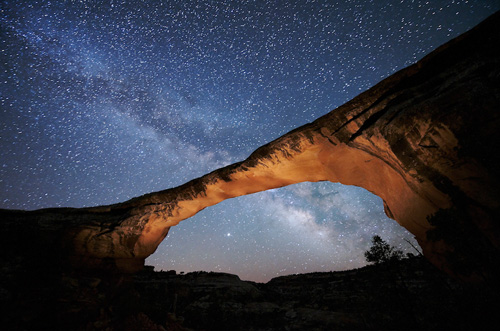
Natural Bridges National Monument, Utah
When I learned that Natural Bridges National Monument had been named the world’s first International Dark Sky Park by the International Dark-Sky Association I knew I’d have to go there. And did it ever pay off! The place is great. Really pristine dark skies, the result of hard work and cooperation by all the area players to keep the spread of bad lighting at bay. The result is that the Milky Way really lives up to its name out there in Southern Utah.
This is where the great advances in digital camera technology would really shine. With my Nikkor 14-24mm f/2.8 mounted on my D3 I could crank up the ISO to 6400 and get the Milky Way to really glow with a 60 second exposure at f/2.8. And shooting at 14mm it was just possible to do that with minimal star movement. To complete the scene, my borrowed assistant hiding under the bush with a flashlight light painting the arch really made it pop. This ended up being the opening spread in National Geographic.
By the way, there are two important tricks to know regarding photographing the Milky Way. One is the exposure: it’s always the same because the galaxy is always the same brightness (and will be for next billion years or so.) The only thing that changes is the surrounding light levels. If you want the Milky Way to be bright you have to find really dark skies.
The second trick is know when the Milky Way is going to be visible. For that I use one of the better astronomy programs called Skygazer. With this you can put in the location on earth, the time of day and see where the Milky Way is going to be on any given date, past or future. So on this night I was able to see that the Milky Way wouldn’t rise until 2:00 a.m., and that I could sleep in the evening before going out to shoot. You can do this months (or years) in advance, and know exactly where the Milky Way will be.
On to Arizona:
Let me tell you, I was pretty elated when I found the Arizona Sky Village, the first dark sky housing development in America. (Every house has a telescope dome built into the roof and there are no street lights.)
But let me be blunt: like most of my pictures I didn’t find it just driving down the road. I found it by doing a lot of research. You can’t pull off a story like this for National Geographic by just wandering around until you find interesting stuff to photograph. This picture resulted directly from conversations with the folks at the International Dark-Sky Association. Finding sources with on-the-ground experience is often critical. Besides that a lot of my pictures come out of internet research, often with just the right Google search. Coming up with the right Google search terms are critical to finding great subjects. I was whooping and hollering for joy around the office when I found this one.
While there I met Canadian amateur astronomer extraordinaire Jack Newton, who has a second home at the village. This is where he does his work finding supernovas — he had found five that YEAR alone. After a night of observing he came out just as dawn was beginning to bring a bit of blue to the eastern sky. So I asked him if I could do a portrait, but warned him that he would have to stand stock still for 60 seconds. He did pretty well. To complete the lighting, during the exposure I had my pickup assistant (the Sky Village development agent) play a flashlight across the arched gate. By now I was getting pretty confident that I could pull off Milky Way images.
Off to Toronto via Detroit:
Two days of hard driving lay ahead of me to get to Detroit. Now I was armed with The Story of English by Melvyn Bragg, a simply wonderful account of the history and development of English as a world language. I was a happy driver. (And I had a new recording of Carmina Burana to wake me up when needed.)
Arriving in Detroit I went straight to the airport where I had found a small plane and pilot to do night aerials of the city. As they say, nice but no cigar. One of my failures on this story. No substitute for Chicago.
But over in Toronto there was another picture to do. Turns out that city lights confuse birds and a lot of them fly into the sides of skyscrapers at an alarming rate. If they are lucky they just knock themselves senseless and drop to the sidewalk. I they are not lucky… well. Amazingly there is a group in Toronto that tries to remedy this problem, called F.L.A.P. (Fatal Light Awareness Program. Found them with another Google search.). They try to rescue the stunned birds that they can and collect the birds that die in order to track the problem. And once a year they pull all those poor dead birds out of the freezer and spread them out on the floor and do a count. You can bet I wanted to be there for that.
Truthfully, I wasn’t sure it would make a compelling picture, but in the event I got lucky. While standing atop a ladder looking down at all our deceased avian friends, a school group came through. And down below me some enterprising teacher called out “Who can show me the Cardinal?” Instantly every school-kid arm went out and I popped off a couple of frames. Job done in Toronto.
Finally, to Chicago, Illinois:
Finally I was going to get to Chicago. As far as I could tell no other city lays out with such geometric precision at night, with infinite lines receding off to the horizon. Several images I had found on the internet gave me hope that I might pull of something special here. Driving back through Detroit I could see that the weather looked good that night in Chicago. A call to my Detroit pilot netted me the name of an outfit in Chicago that had Cessna’s and could fly me for the aerials. Call ’em up. If I could get to Chicago by 11:00 that night, could they take me up at midnight to shoot pictures? Luck favored me again, because the pilot said yes, if his girlfriend could go along. Fine by me!
Shooting aerials of cities at night has added problems beyond the mere photographic difficulties. Mainly, the air space is heavily controlled. So I was really glad that my pilot knew the O’Hare traffic control setup very well, and knew what we could legally (and safely) do and how to do it. Mainly that meant getting above 10,000 feet and staying out of the “inverted wedding cake” of restricted zones over O’Hare.
But that was fine because from 10,000 feet up Chicago was just stunning as we approached from the West. Then, to my horror, I could see disaster looming: clouds drifting in from the lake, threatening to obscure the city before we could get there. Miraculously the clouds stayed broken with nice openings below and they were even thin enough to offer a beautiful transparent view of the street lights underneath them. From panic I went to ecstasy. The view was incredible.
Whipping out the D3 I went to work. I was, however, a bit alarmed to find that the exposure was 1/13th of a second at f2 and ISO 4000. You’re not supposed to be able to shoot sharp pictures from a small plane at 1/13th of second! But I had ignored that common wisdom before and knew that with really calm air (which we had) you could shoot a sharp frame now and then. (The main trick is to NOT lean on the window and not get the lens out in the slip stream of the prop.) So we circled about 20 times while I did hundreds of frames looking for just the right placement of clouds over downtown. In the end there were a lot of frames that were usable but this arrangement really pulled it all together. You can bet I thanked my pilot (and his girlfriend) for giving up their evening for me.
The next morning I slept in.
By that afternoon I had emailed some of the better frames to veteran National Geographic picture editor Bill Douthitt. He agreed we had the goods. I could go home. I’d still have to go to Florida to shoot endangered sea turtles the next month, but I could fly to that. For now I could relax and enjoy a leisurely drive back over the next two days.
Truth is, I was sorry the adventure was over. Thirty days on the road, a little over 6,000 frames (not many for a full story), something over 4,000 miles driven, four audiobooks finished, listening to Brahms symphonies really loud on the car stereo… Oh, and a back seat full of burger boxes. Doesn’t take a lot to make me happy.
For me, this is the romantic side of shooting for National Geographic, and I love it.
Postscript: We later learned that after our story came out the city of Chicago initiated a full scale review of their lighting regulations, and the International Dark-Sky Association cited our story as the major event of the year in their efforts to save the night for future generations. Oh, and I got the cover of the Magazine. Some times things work out for the best.
You can see more of Jim’s work at JimRichardsonPhotography.com and keep up with his blogging for National Geographic



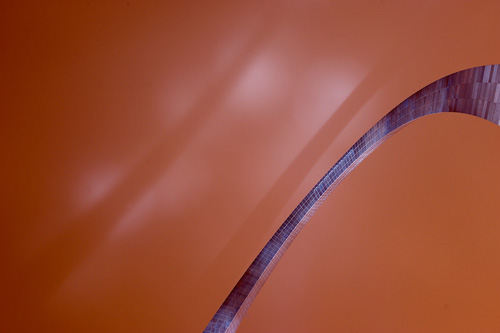
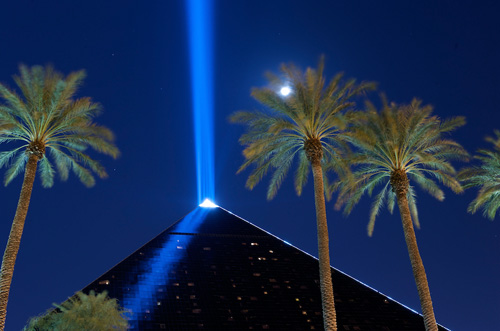
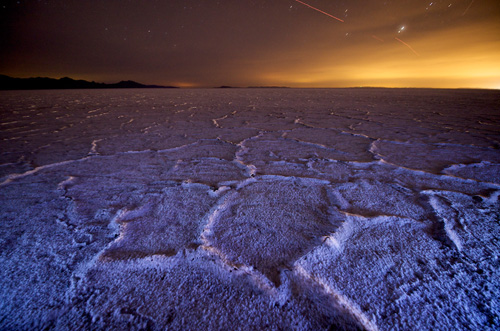
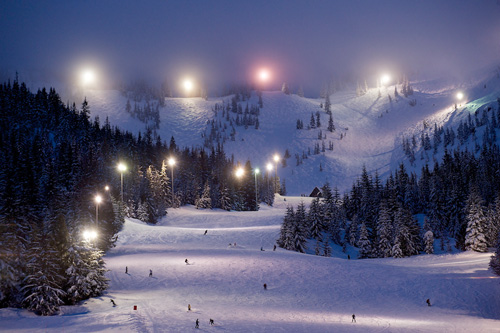
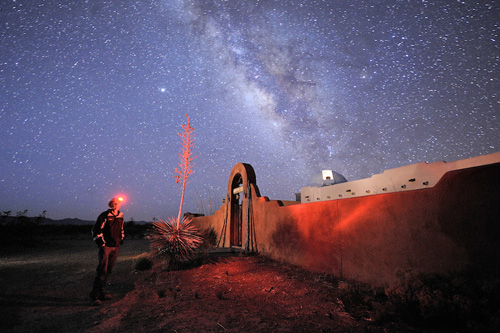
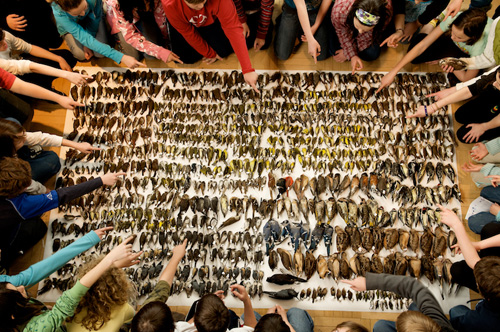
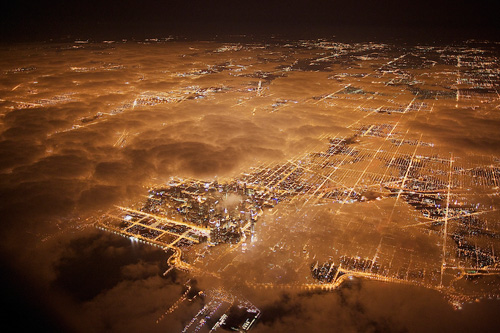
Wow Jim, great post! It’s amazing what the city lights do to the night. Thanks
This blog needs more posts like Jim Richardson’s, telling what life is like in the real world. Kudos to whoever decided to start the series on National Geographic photographers.
What a marvellous post; great story and superb images. There is nothing like looking at a star lit night to really emphasise how small we are in the big scale of things.
Jim, Brilliant work ,writing and a great passion. My favorite oddity is the avian shot taken in Toranto. Beautiful Natural Bridges shot and amazing Milky Way image from AZ. I love car travel too and really enjoyed tagging along with you.
Sold to the gentleman in the first row! I’m now going to investigate the cited F.L.A.P, International Dark Sky Association, SkyGazer software, and even Melvyn Bragg’s book. Rest assured a National Geographic regular knows how to both write and photograph compellingly. More!
Jim, superb work as usual and an inspiration. Ever since I first saw your aerial photo of the “Wheat Harvest” over Kansas I’ve been an avid fan and follower. May you continue to produce brilliant photographs for many years to come. Thank you.
Best guest blog so far! Really enjoyed reading it, thanks.
Waw.. what a wonderful sky with the stars at the Natural Bridges National Monument, Utah
Great story!! Really enjoyed reading this!!
Great post!
What a fantastic read and fascinating subject. Thanks for sharing.
Great story, quite an insight to the lazy romantic life of a NG photographer. Get up before dawn, listen to some classical music, take a leisurely drive in the country side and shoot a few pictures, eat some burgers and go to bed again. What a life. LOL.
Jim, thanks for that awesome back story. Makes me appreciate those NG stories I read every month even more. It’s no wonder you got the cover with writing & pics like this.
I’m 44 years old and to the best of my recollection, I have never seen the Milky Way. If I have seen it, it was as a child and has long since been erased from my memory. Thanks for sharing the “romance” and the reminder of what kind of commitment it takes to get the shot!
Amazing images, great read, fantastic post. Thanks!
Other than the Bible (Leviticus being the exception:-), in today’s fast paced world this amount of text generally will not keep my attention. But not this time! Really good reading, thank you for the great post.
Wow, excellent read. Thank you! :)
Captivating and informative. I hope there will be more of these.
Awesome story, I felt like I was right there with you! I love all of the shots you posted but especially the one of the Milky Way from Utah. I have yet to get a good photo of the Milky Way, but thanks to your post, I’ll have some better ideas of where to look!
Again, big kudos to Scott and Brad, for the Nat Geo photographer series!!
This is a fascinating blog post and with equally fascinating photos! I loved it!
Wow! That was a great read. We’re going to enjoy this one during our lunchtime photo forum, today! Thank you very much!
Jim,
I thoroughly enjoyed this read and the wonderful pictures. Makes me want to get up in the middle of the night and see if I can’t get a few frames of the Milky Way. Thanks for sharing.
Mr. Richardson:
This was a great post. I always love reading the stories behind the photos. That Chicago shot is beautiful! Man that would look great enlarged and printed on metal. Could see that hanging in my office.
I am really loving this series of guest bloggers. So fascinating!
Great article Jim. Thank you for sharing.
Kind regards
Kamyar
Thanks, Mr. Richardson, love your rendering of the Natural Bridges National Monument. I would never have thought to use light painting.
I remember that article and being blown away by the photos. It was a real treat hearing the story behind it.
This post made me feel like I was there. Thank you
Really enjoyed reading your story. I always wondered how people got amazing images of all the stars and milky way in the sky. Certainly don’t see it any where Ive been. ( but i dont travel much) Looked at your images on your blog and site as well. You’ve got some amazing stuff.
Thanks. :-)
Hi everybody. Jim here. Really glad you liked the post. This is a great blog site so I wanted to offer up something worthwhile. And I also like to take a bit of the wind out of the photographer mystic. We’re just working stiffs here, so I really appreciate your kinds remarks.
Jim
I really enjoyed this post! The photo of Gateway Arch totally grabbed my attention, and the shot of Chicago is just fantastic – from an aesthetic standpoint – and for the amount of pure chance that was involved in the circumstances. I have been doing a lot of night photography recently – mostly for time lapse sequences – and I was amazed at the level of light pollution – even in areas that look dark to the eye.
Great Story. I’m going to spend the weekend camping with my son’s Cub Scouts pack and visiting our local observatory – the George Observatory, South West of Houston, TX. A few years ago, the GO objected to a new Walmart development near my house, some 30 miles away. The GO lost and the Walmart (and others) got built. Interesting from a photography viewpoint was a large part of the GO objection was the parking lot lights would be pointing down into a giant white concrete reflector – kind of like bouncing your flash off a white wall.
I’ve been fortunate enough to spend many years in northern and southern Africa. When I look up at the night skies where I live now, I still struggle to consider how star poor I have become.
The amazing part of the WalMart building and other similar ‘developments’ is that for the sake of someone’s commerce and profit, valuable scientific instuments can be rendered useless without any compensation to the people (usually taxpayers and a few private donors) who initially put up the money.
If the light polluter could be made to pay for damages, we would see a lot less light pollution. And other pollution.
Jim, awesome post, very inspiring!
KT
Terrific post, Jim!! Thank you. I loved the photos and your “behind the scenes” notes. Light pollution is an important topic, and one that we can actually resolve, so I’m glad for the NG coverage of this issue/challenge.
Jim, I remember reading the article in the NG a while ago and thinking how unaware I was of the light pollution problem and how fascinating I found it. It sent me back to a trip I took many years ago in Australia. Sleeping outside in an aboriginal settlement in the outback, near Alice Spring and looking up at the sky in the middle of the night. I would never forget the feeling I had of drowning in this immense sky lit up by an endless number of stars!! How small I felt and how big the sky was! A great experience for anybody with a big ego!
Thanks for sharing with us what was behind those beautiful pictures in the NG.
I almost never get to see more than a few stars at night because the Northern Virginia area is awash with light pollution. I never really gave it much thought but after reading Jim’s article I am going to take advantage of my trip to Peru next week to look up at the night sky while visiting some of the more remote areas. I’m curious to see just what I am missing.
Great post Jim!
Great post, great story, thanks for sharing!
WOW. What a great story from so many different angles.
Thanks!
Excellent read, Jim. I’ve complained about light pollution for many years, but it really has gotten worse lately (or so it seems to me). I took my kids to my brother’s home in NH one year and they were amazed at seeing the Milky Way in all its glory. You can’t see it where I live in MA.
Thanks for sharing,
–John
Thanks for posting this and helping document this problem. This has really been beneficial in the discussion on light pollution.
-Robert Wagner
Board Member, International Dark-Sky Assocation
Robert, thanks for the note. Glad I can be of some small help to all of you who have put so much work into this problem. You can always call on me if there is something I can do.
Jim, one can feel your passion in every single line of the post. Seldom I read through them to the end but yours is different, such a pleasure. Thanks for taking the time to write!
Arved Gintenreiter
Terrific pictures as always, but great writing as well, as you tell the compelling and fascinating story of how knowledge and a little luck got you these great images. Thank you!
Great post.
Wonderful, just like your entire career. I’ve long been a real fan, in the early 70’s my photographic career took a major turn after seeing your heartfelt B&W slide show on the small Kansas town and it’s Doctor. I’ve long considered your work, and heart for imaging and people among the few worth emulating!!!!!! Thanks for inspiring us………
Bill, sorry for the delay. Thanks so much for your kind comment. Means a lot coming from you. I’ve always done what I enjoyed in photography and putting the pictures to work always matters to me. So to hear that someone got something out of them makes my day.
Best,
Jim
Loved this one! Thanks for sharing your passion with us.